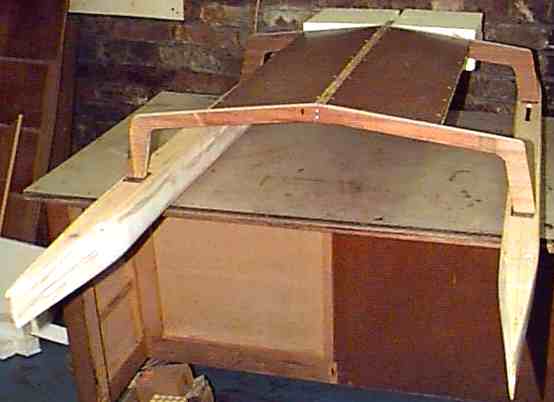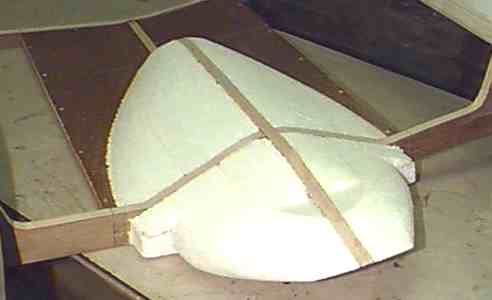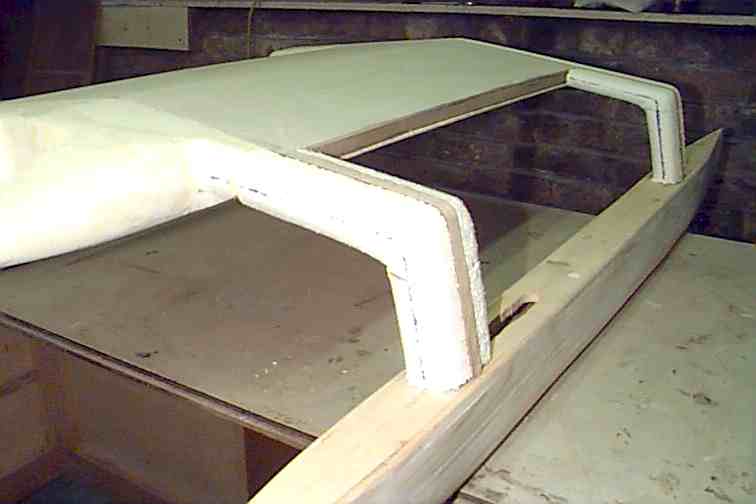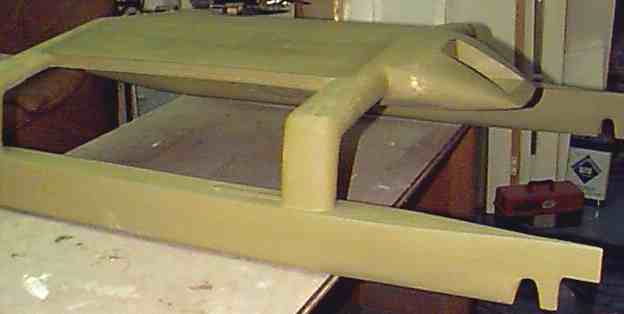|
|
|
|
HOME | BIOLOGY | FILMS | GEOGRAPHY | HISTORY | INDEX | INVESTORS | MUSIC | NEWS | SOLAR BOATS | SPORT |
|
|
Solar Navigator underwent a re-design after build estimates were received for the SWATH vessel. It was decided the project total cost would put off potential sponsors, if the SWATH design went ahead to production.
Traditional timber construction + polystyrene to carve pod
Consequently, traditional multi-hulls came under the spotlight as a possible solution. The cost of constructing a catamaran is roughly half of the equivalent SWATH vessel.
The next question was could a catamaran offer a level of performance to allow a full size Solar Navigator to cross blue water. The only way to find out was to build a model and see.
Details of underside - crew rear pod - shaped
We were pleasantly surprised with the performance of the catamaran featured on this page. The wooden hulls shown here were replaced with fiberglass. Although rather heavy, when fitted with the correct propeller and drive, and even on only 6 watts of solar energy, she performed sufficiently to prove the theory.
A new lightweight aluminium spaceframe is going into the next catamaran development model. An active Tracking system is to be incorporated to ensure maximum energy collection from the solar panels.
Polystyrene was added to plywood legs for shaping
It is hoped that a number of design revisions will push up the performance quite spectacularly, as a further inducement to associates and potential sponsors to invest in our project.
Hulls and superstructure primed
In 1995 it was proposed by our designer that a solar powered boat would be able to circumnavigate the globe using only energy from nature. He displayed the first of his development models at the Earls Court boat show in London into 1996.
With a boat the most important component on the agenda is the hull. Solar powered boats provide marine architects with new challenges. There are as yet no conventions. Nobody knows what will work best, because so little has been put to the test. We can attest to that because we've tried 5 hull designs to date, improving on each one. Two SWATH designs (one above), two catamarans and a trimaran. The 6th design is not strictly speaking a trimaran, it does though have three hulls; so we're billing it as a trimaran. A hull design like this has not been built to date, to overcome the ever present drag and wave drag dilemma.
The other major challenge is panel design. How do you increase panel area and get as much of it facing the sun when the sun moves relative to the route, and of course keep the boat stable in all seas. We wanted at least 2 kilowatts per ton of vessel mass and can comfortably achieve that. Not to detract from the incredible achievements of the PlanetSolar team, but the SolarNavigator project aims to improve on the record 0f 585 days set in May 2012 with our brand new design. Our advantage is that we have more than twice the power to weight ratio of the current record holder with a lower drag hull. This needs to be verified before we can go to the construction stage.
This project represents a unique opportunity for any global company with eco friendly ambitions. If this is of interest to you please let Blueplanet Productions know using the contact details below. See the breathtaking video of PlanetSolar below to get a handle on the sort of publicity that Solarnavigator can generate.
Planet Solar Youtube & Planet Solar docking in Hong Kong
On the 4th of May 2012 the theory was proven to be correct by Raphael Domjan and his superb boat the Turanor Planetsolar, thanks to generous sponsorship by Candido Swiss watches and Immosolar, leaders in the field of solar energy management.
Now the benchmark has been set, it will undoubtedly inspire others. As with so many things once a pioneer has shown the way, inevitably, the record stands like mountain to be scaled.
WE WILL PUBLISH DETAILS OF THE LATEST MODEL BUILD SHORTLY
The latest Solarnavigator is a battery electric trimaran with an extremely efficient active hull that runs on solar power. The model shown here is just 150mm long. The radio controlled test model is 2.1 meters in length.
|
|
|
This website is copyright © 1991- 2013 Electrick Publications. All rights reserved. The bird logo and names Solar Navigator and Blueplanet Ecostar are trademarks ™. The Blueplanet vehicle configuration is registered ®. All other trademarks hereby acknowledged and please note that this project should not be confused with the Australian: 'World Solar Challenge'™which is a superb road vehicle endurance race from Darwin to Adelaide. Max Energy Limited is an educational charity. |
|
|
AUTOMOTIVE | BLUEPLANET | ELECTRIC CARS | ELECTRIC CYCLES | SOLAR CARS | SOLARNAVIGATOR |




